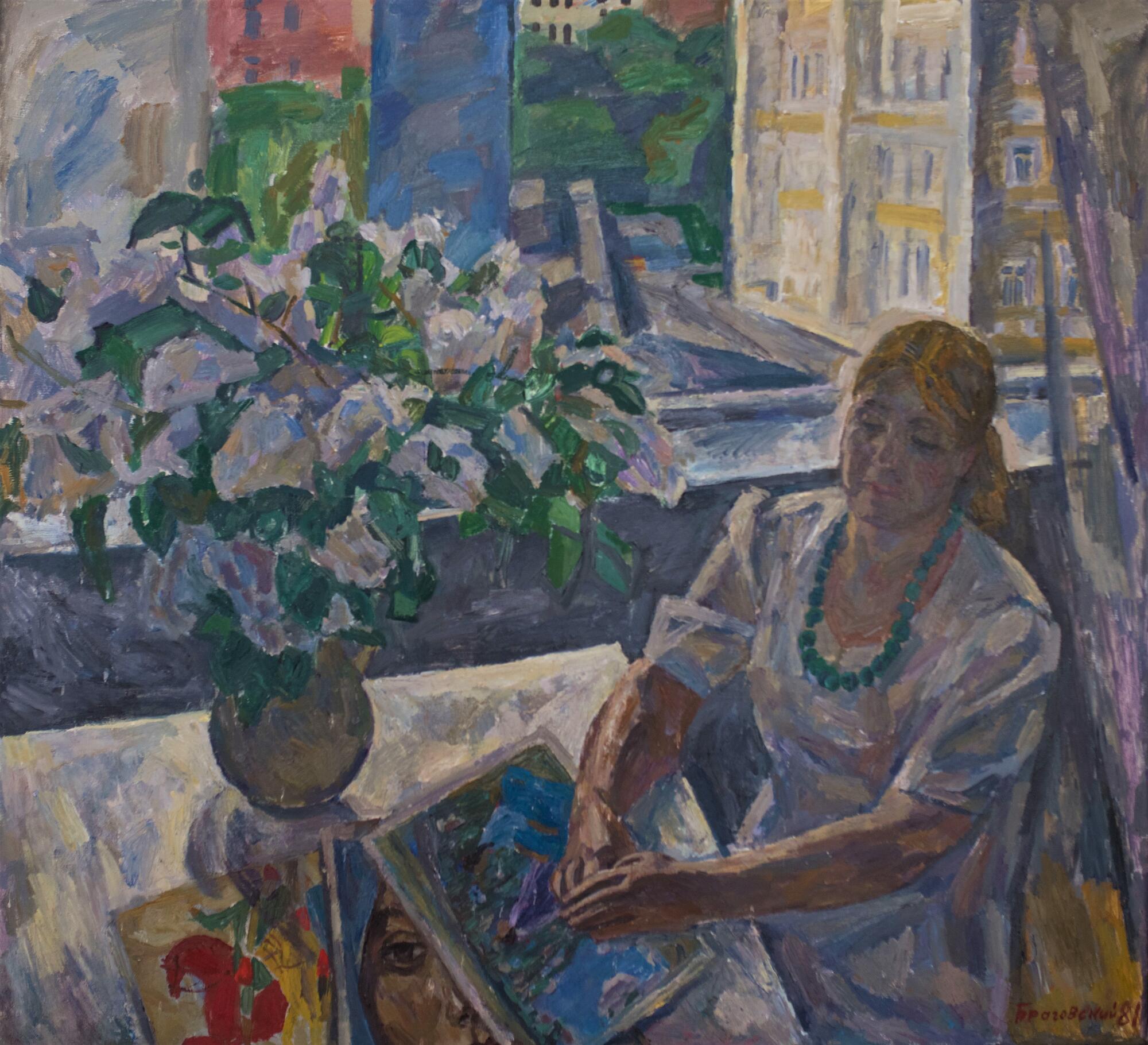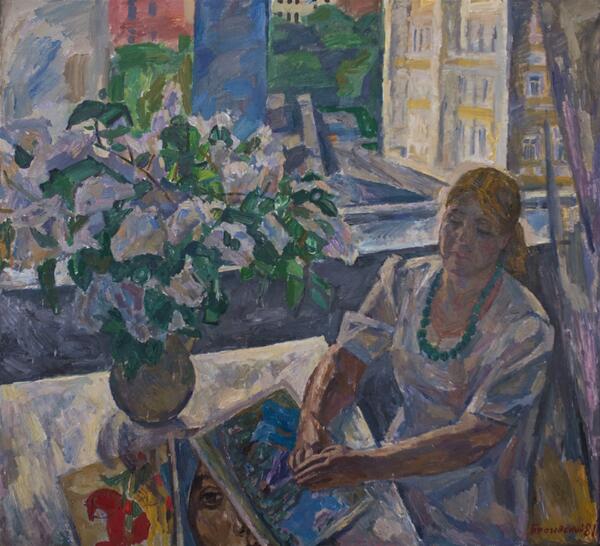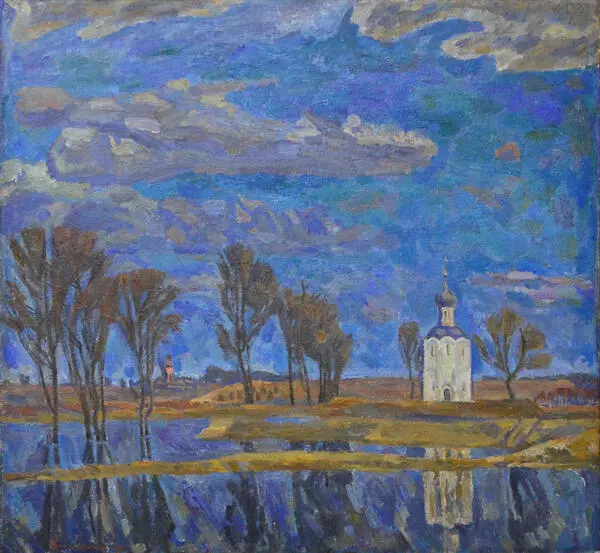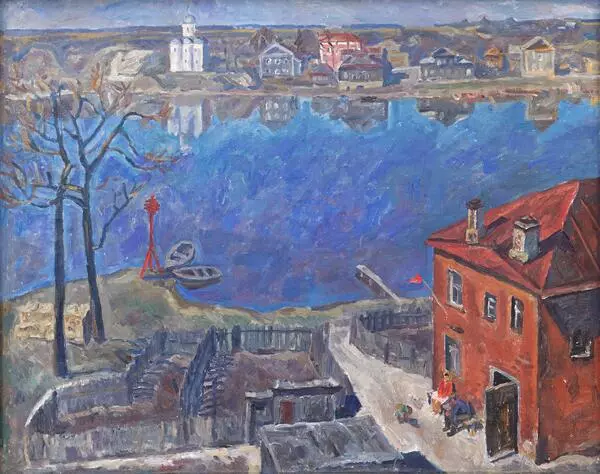Artist Eduard Bragovsky created the painting “White Lilac” which is housed in the Volzhsky Art Gallery in 1981. This is a portrait of a woman in an interior setting depicted against the background of an open window. A thoughtful woman sits at the table in a simple light dress with short sleeves and a string of large beads around her neck. There is a big bouquet of white lilac with green leaves in a vase on the table.
The focal point of the composition is the bouquet. The color palette of the flowers echoes the one of the character’s clothes. For Bragovsky, color was the main means of expression, a figurative form that was able to fully embody one’s artistic idea.
Bragovsky painted the canvas with vigorous, thick and bold brush strokes. Despite the static nature of the image, the space in the painting is filled with air and light. From the bouquet, the viewer’s gaze goes beyond the city apartment, to where the street greenery echoes the fresh leaves on the bouquet.
Eduard Bragovsky was born in 1923 in Tiflis (modern Tbilisi) in the family of a career military officer. In 1927, the family moved to Moscow, and Bragovsky began to attend an art studio in the capital. In 1939, he became a member of the children’s editorial board of the magazine “Young Artist”. During the Great Patriotic War, Bragovsky’s mother died during evacuation. Eduard kept in touch with the partisans. From 1943 to 1946 he served in the Red Army.
After the war, Bragovsky entered the State Art Institute in Vilnius, and then continued his studies at the Surikov State Art Institute in Moscow. After graduation, he, along with other young artists, participated in the first youth exhibitions held in Kuznetsky Most in Moscow.
Eduard Bragovsky is considered one of the most optimistic artists of his time. The artist was proud that he belonged to the generation of the 1960s, which in the Khrushchev Thaw era of the mid-1950s — mid-1960s changed the development of Russian fine art.
Bragovsky worked for many years in the Moscow Union of Artists, was chairman of the painting department, a member of the Board of the Moscow Union of Artists. He painted landscapes, portraits, still lifes, and narrative compositions. Presently, his paintings are exhibited in the Tretyakov Gallery, the Russian Museum and in most major museums in Russia and the Commonwealth of Independent States, as well as in museums in the USA, England, Germany, Spain.
In 2000, Bragovsky became a laureate of the State Prize of Russia, and 10 years later received the title of People’s Artist of the Russian Federation. Bragovsky died in 2010 in Moscow and was buried at the Old Cemetery in Tarusa.
The focal point of the composition is the bouquet. The color palette of the flowers echoes the one of the character’s clothes. For Bragovsky, color was the main means of expression, a figurative form that was able to fully embody one’s artistic idea.
Bragovsky painted the canvas with vigorous, thick and bold brush strokes. Despite the static nature of the image, the space in the painting is filled with air and light. From the bouquet, the viewer’s gaze goes beyond the city apartment, to where the street greenery echoes the fresh leaves on the bouquet.
Eduard Bragovsky was born in 1923 in Tiflis (modern Tbilisi) in the family of a career military officer. In 1927, the family moved to Moscow, and Bragovsky began to attend an art studio in the capital. In 1939, he became a member of the children’s editorial board of the magazine “Young Artist”. During the Great Patriotic War, Bragovsky’s mother died during evacuation. Eduard kept in touch with the partisans. From 1943 to 1946 he served in the Red Army.
After the war, Bragovsky entered the State Art Institute in Vilnius, and then continued his studies at the Surikov State Art Institute in Moscow. After graduation, he, along with other young artists, participated in the first youth exhibitions held in Kuznetsky Most in Moscow.
Eduard Bragovsky is considered one of the most optimistic artists of his time. The artist was proud that he belonged to the generation of the 1960s, which in the Khrushchev Thaw era of the mid-1950s — mid-1960s changed the development of Russian fine art.
Bragovsky worked for many years in the Moscow Union of Artists, was chairman of the painting department, a member of the Board of the Moscow Union of Artists. He painted landscapes, portraits, still lifes, and narrative compositions. Presently, his paintings are exhibited in the Tretyakov Gallery, the Russian Museum and in most major museums in Russia and the Commonwealth of Independent States, as well as in museums in the USA, England, Germany, Spain.
In 2000, Bragovsky became a laureate of the State Prize of Russia, and 10 years later received the title of People’s Artist of the Russian Federation. Bragovsky died in 2010 in Moscow and was buried at the Old Cemetery in Tarusa.






